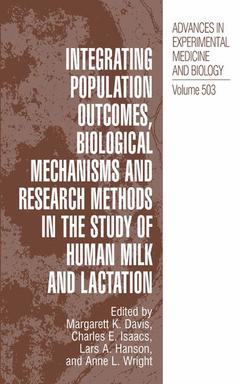Description
Integrating Population Outcomes, Biological Mechanisms and Research Methods in the Study of Human Milk and Lactation, Softcover reprint of the original 1st ed. 2002
Advances in Experimental Medicine and Biology Series, Vol. 503
Coordinators: Davis Margarett K., Hanson Lars A., Isaacs Charles E., Wright Anne L.
Language: English
Subjects for Integrating Population Outcomes, Biological Mechanisms...:
Integrating Population Outcomes, Biological Mechanisms and Research Methods in the Study of Human Milk and Lactation
Publication date: 10-2012
338 p. · 17.8x25.4 cm · Paperback
Publication date: 10-2012
338 p. · 17.8x25.4 cm · Paperback
Integrating population outcomes, biological mechanisms and research methods in the study of human milk and lactation
Publication date: 05-2002
346 p. · Paperback
Publication date: 05-2002
346 p. · Paperback
Description
/li>Contents
/li>Comment
/li>
Integrating Population Outcomes, Biological Mechanisms and ResearchMethods in the Study of Human Milk and Lactation is the product of the 10th Conference of the International Society for Research on Human Milk and Lactation, held on September 15-19, 2000, in Tucson, Arizona. The presented sessions at the meeting are as diverse as the volume itself. These sessions include the impact of micronutrient deficiencies during lactation on maternal and infant health, the premature infant, developmental immunology, breastfeeding in the industrialized world, and viral transmission in milk. Whenever possible, the sessions were organized to include human population research, research showing the biological underpinnings of the effects on human health, and important methodological issues. This volume is a contemporary and influential tool for human milk biologists, breastfeeding epidemiologists, biochemists, immunologists, clinical specialists, and all professionals and researchers in the field.
The Secretory Immunoglobulin System: Regulation and Biological Significance; P. Brandtzaeg. The Milky Way: from Mammary Gland to Milk to Newborn Macy-György Award Presentation (1999); M. Hamosh. A Half-Century Inquiry into the Immunobiology of Human Milk Macy-György Award Presentation (2000); A.S. Goldman. Section I: The Impact of Micronutrient Deficiencies during Lactation On Maternal and Infant Health. Vitamin A and the Nursing Mother-Infant Dyad: Evidence for Intervention; R. Stoltzfus. Diarrhea, Growth and Feeding in Developing World; S. Zaman. Impact of Maternal Vitamin B-12 Deficiency during Lactation On Maternal and Infant Health; L. Allen. Zinc Requirements for Breastfed Infants; N. Krebs. Section II: The Premature Infant. Breastfeeding and Cognitive Outcomes among Premature Infants; R. Morley. The Role of Human Milk I Necrotizing Enterocolitis (NEC); M. Caplan. The Effect of Stress on Lactation - Its Significance for the Premature Infant; C. Lau. Section III: Developmental Immunology. Overview: Immune System Modulation by Human Milk; L. Hanson. Intestinal Absorption of Lymphocytes; S. Tuboly. Risk for Celiac Disease in Childhood; L.Å. Persson. Human Milk and Apoptosis of Cancer Cells; M. Svensson. Infant Feeding and Auto-Immune Diabetes; M. Dosch. Section IV: Breastfeeding in the Industrialized World. Protective Effect of Breastfeeding against Infection in the First and Second Six Months of Life; P. Howie. Evolutionary and Neuroendocrine Aspects of Care of the Mother and Newborn; J. Winberg. Lactogenesis and Infant Weight Change in the First Weeks of Life; K. Dewey. Section V: Viral Transmission inHuman Milk and Colostrum: Mechanisms, Potential Interventions and Implications For Breast-feeding Promotion. Protective Effects of BMin Developing World; E. Giugliani. Specific/nonspecific Protective Factors in Milk: Why don't they work?; C. Isaacs. Cellular Transmission of Viruses (HTLV, IV); S. Southern. Prevention of Vertical Transmission of HIV: Strategies, successes, and Failures; P. van de Perre. Section VI: Breastfeeding and Reproductive Health. Lactational Endocrinology: The Biological Basis for LAM; A. McNeilly. Efficacy and Effectiveness of LAM in the Industrialized and Developing World; K. Kennedy. Effects of Maternal Obesity on Lactation Performance; K. Rasmussen. Use of Ethnographic Approaches in Understanding Health Effects Related to Breastfeeding; D. Sellen. Section VI: Abstracts. Maternal Smoking Habits and Fatty Acid Composition of Human Milk; C. Agostoni. Major Breast Milk Carotenoids of Health Mothers from Nine Countries; L. Canfield. Maternal Milk Composition is not Associated with Current Dietary Intake, but with Body Composition after Three Months Post-Partum in Two Mexican Regions; G. Caire. Vitamin A in breastmilk and HIV infection in West Africa; K. Castetbon. Milk Transfer Volume at the Time of Maternal Perception of the Onset of Lactation; D.J. Chapman. Intra-Individual Changes of Fatty Acids in Breast Milk due to the Suckling Stimulus; T.H.M. Da Costa. Training on Breastfeeding in Italy; R. Davanzo. Body Composition of Lactating Mothers at the First Month Post-Partum Depends on Post-Gestational Body Weight; L.M. de Regil. Milk-Borne EGF and Necrotizing Enterocolitis in Neonatal Rat Model; B. Dvorak. Concentrations of Interleukin-10 in Prete
'For an IBCLC who looks beyond the practical research that informs her daily work, this is a find. Entries can be read separately, the index is fairly comprehensive, and in none of the acknowledgements is there any reference to the infant formula industry. An alphabetical list of contributors with contact details simplifies follow-up. All in all, this volume is a useful, if pricey, addition to the lactation library.'Journal of Human Lactation, 20:1 (February 2004)
© 2024 LAVOISIER S.A.S.




